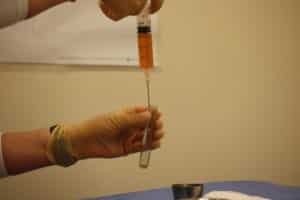
Walden Cosmetic Surgery and Laser Center in Austin, Texas is now performing microneedling with platelet-rich plasma therapy (PRP) as a proactive therapeutic option for male and female patients experiencing hair loss. PRP is an exciting non-surgical therapeutic option for patients who may benefit from stimulation of hair growth for hair loss conditions.
Many people are concerned about thinning hair and loss of hair on areas of their head whether caused by the aging process or various medications. If you’re one of them, you may also be reading and hearing how our own blood can help restore a youthful appearance to skin, and interestingly, about the possible benefits PRP is achieving to promote hair growth and preventing further hair loss.
- Noticing thinning hair?
- Small Areas of Baldness?
- Receding Hairline?
- Loss of Volume?
- Self-conscious?
PRP hair restoration can help to naturally reverse thinning hair by increasing hair thickness and stimulating a healthy growth of hair follicles. It does not re-grow hair.

How Does PRP Hair Restoration Work?
Human blood contains mesenchymal stem cells, and autologous blood products that contain essential and specific growth factors that assist in tissue regeneration and healing.
In the field of hair restoration, evidence supports PRP therapy as a promising treatment option to promote hair growth, yet there are no solid evidence-based claims of its efficacy. While PRP is in the early stages of scientific research in hair restoration, PRP is not meant to replace current FDA approved therapies such as DHT blockers and Minoxidil. But, it is a promising non-surgical therapeutic option for those patients with hair loss.
Who Is a Good Candidate for PRP for Hair Restoration?
PRP has been successful in other medical and surgical disciplines for many years. The decision to use PRP is a personal decision and should involve after careful research, consideration, and consultation with a physician. PRP is safe and natural because the procedure concentrates the good cells from your scalp and injects them directly back into the needed area. There is absolutely no chance of getting a blood infection from another human being. PRP involves using your own cells that are unmodified to prevent rejection by your immune system.
Hair Transplant Procedure
Blood is drawn in our office as though you are having routine blood testing at your primary care physician’s office. The blood spins in a centrifuge and the PRP separates from the rest of the blood.
We use the PRP taken from your body and specially prepare it by spinning down the blood cells to a high concentration. It is a closed sterile system and the platelets are concentrated to 3X the normal blood values. Also, the system eliminates granulocytes which hurts tissue regeneration and wound healing. Then, an anesthesia block used on the nerves of the scalp helps the patient to not feel any pain.
Next, we inject the highly concentrated platelet rich plasma (PRP) into the scalp. We then wash the patient’s hair and they may drive home without any assistance unless they recieve Valium. We require an escort to drive you home if you receive sedation or any pain medication. Many people do not need sedation due to the fact that Dr. Walden can give you local anesthetic blocks of the scalp region prior to the injections being administered.
PRP contains many growth factors that stimulate the hair follicle’s growth. PRP can be preoperative, intraoperative, or postoperative in many types of surgical procedures. Some patient’s chose to have PRP performed every three (3) to four (4) months as early data suggests regular or semiannual PRP treatments that may stimulate hair growth.
PRP Hair Restoration Images









How PRP Hair Therapy Works
PRP contains special cells called platelets that can theoretically cause growth of the hair follicles by stimulating the stem cells and other cells in the environment of the hair follicle. These special platelet cells promote healing, accelerates the rate and degree of tissue healing and regeneration, responds to injury, and formation of new cellular growth. Therefore, the primary purpose of using PRP in hair restoration is to stimulate inactive or newly implanted hair follicles into an active growth phase.
PRP specific cells that causes hair growth include:
- Platelet-Derived Growth Factor (PDGF) — promotes blood vessel growth, cell replication, skin formation;
- Transforming Growth-Factor-Beta (TGF-b) – promotes growth of matrix between cells, bone metabolism;
- Vascular Endothelial Growth Factor (VEGF) — promotes blood vessel formation;
- Epidermal Growth Factor (EGF) — promotes cell growth and differentiation, blood vessel formation, collagen formation;
- Fibroblast Growth Factor-2 (FGF-2) — promotes growth of specialized cells and blood vessel formation; and,
- Insulin Like Growth Factor – (IGF) — a regulator of normal physiology in nearly every type of cell in the body
How Effective Is PRP Treatment?

Individual results vary with each patient. While there are no guarantees, PRP preliminary studies indicate patients can respond to PRP therapy. Surgeons can then apply PRP for those patients who are not surgical candidates every three (3) to four (4) months. Other protocols will use PRP before or during surgery to ensure graft survivability. Extensive clinical trials are not complete and medical data is not yet published to establish the absolute effectiveness of PRP. Therefore PRP is not necessarily a “cure” for hair loss and there are no guarantees about its individual effectiveness.
No claim of PRP efficacy in promoting hair growth can be made because there is no FDA approval that would allow such claims to be made.
PRP is a potential emerging non-surgical based therapy for natural hair follicle stimulation for thinning hair. Larger clinical studies are pending but the current medical literature contains numerous optimistic results. Although a few controlled studies exist, anecdotal and case reports are the primary sources reflecting success with PRP therapy.
Who Should Not Have PRP Treatment?
Patients with history of heavy smoking, drug and alcohol use. Medical diagnosis such as:
- Thrombocytopenias
- Platelet Dysfunction Syndromes
- Hypofibrinogenaemia
- Hemodynamic Instability
- Sepsis
- Acute and Chronic Infections
- Chronic Liver Disease
- Anti-Coagulation Therapy
- Chronic Skin Diseases or Cancer
- Metabolic and Systemic Disorders
Can I Use Other Hair Loss Treatments?
Absolutely. In fact, we encourage it and prescribe PRP therapy as a compliment to a nonsurgical approach for those patients who are not eligible for surgery or who want to delay hair restoration surgery. In addition, we recommend PRP therapy along with Minoxidil and DHT blockers or for those patients who can not tolerate or have side effects with these medications.
Schedule a Consultation
In summary, PRP therapy offers the opportunity for hair growth for those patients who are not candidates for surgery. It can also help patients wanting a more aggressive nonsurgical approach to treatment. Whether you are looking for additional hair stimulation in male pattern baldness or have alopecia, Walden Cosmetic Surgery Center may be able to meet your needs.
Results may vary from patient to patient, and PRP as a non-surgical option has not been offered to patients with miniaturization and hair thinning improvement in hair caliber and thickness. For more information please contact the office to arrange a consultation with Dr. Walden and her team at 512-328-4100.





